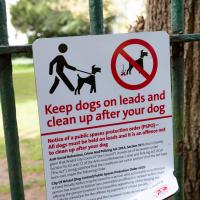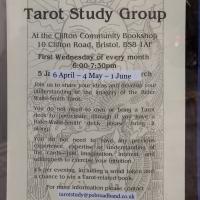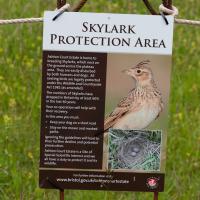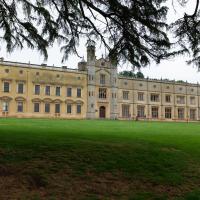Tagged: it
Easter Monday Gardens and Flowers
18 Apr 2022
I didn't really set out with a theme of flowers and gardens in mind for this walk. I just fancied heading up to Clifton Village to get lunch. As it turned out, though, Spring was springing, so a minor theme emerged as I started off with the graveyard flowers of Hope Chapel and wandered up to see the beginnings of the new wildflower garden at Clifton Hill Meadow.
There's been some commotion on Nextdoor about the recent appearance of this sign. Lots of people who have been letting their dogs off their leads in the churchyard for decades have been rather up in arms. I'm not sure there's actually much danger of the rozzers issuing ASBOs or fines to the locals for that kind of infraction, though.
Tags: Bristol Places UK onemilematt united kingdom Clifton Village Clifton St Andrew's churchyard birdcage walk Lime Walk
Auto-Tags: Green White Nature Natural environment Grass Font Biome Line Plant Public space Woody plant Tree Signage Motor vehicle Street sign
Text Recognition Tags: ㅅ Keep dogs on leads and clean up after your dog Notice of a public spaces protection order (PSPO)- All dogs must be held on leads and it is an offence not to clean up after your dog Anti-Social Behaviour Crime And Policing Act 2014, Section 59Notice is hereby given that Bristol City Council (the Council) in exercise of its powers under Section 59, 63 and 72 of the Anti-social Behaviour, Crime and Policing Act 2014 The Act, being satisfied that the conditions set out in section 59 of the Act have been met, made the following Onder City Of Bristol (Dog Control) Public Spaces Protection Order 2020. A Fored Penalty Notice may be issued to a person who a comitable or authorised person has reason to believe has committed an offence in relation to this One offering the person to whom it is issued the opportunity of dischinging any lability to conviction for the offence by payment of a fiend penalty Scene dog fouling provisions and the Exclusion Zones de not app assistance dogs Further information about the PSPO and the front of the Onder can be found at Public Space Protection (PSPO)-bristol.gov.uk ㅅ Keep dogs on leads and clean up after your dog Notice of a public spaces protection order ( PSPO ) All dogs must be held on leads and it is an offence not to clean up after your dog Anti - Social Behaviour Crime And Policing Act 2014 , Section 59Notice is hereby given that Bristol City Council ( the Council ) in exercise of its powers under Section 59 , 63 and 72 of the Anti - social Behaviour , Crime and Policing Act 2014 The Act , being satisfied that the conditions set out in section 59 of the Act have been met , made the following Onder City Of Bristol ( Dog Control ) Public Spaces Protection Order 2020 . A Fored Penalty Notice may be issued to a person who a comitable or authorised person has reason to believe has committed an offence in relation to this One offering the person to whom it is issued the opportunity of dischinging any lability to conviction for the offence by payment of a fiend penalty Scene dog fouling provisions and the Exclusion Zones de not app assistance dogs Further information about the PSPO and the front of the Onder can be found at Public Space Protection ( PSPO ) -bristol.gov.uk
From the window of the community bookshop. A book I'm vaguely thinking of writing involves the Tarot, and I'm a little tempted to go on this.
Tags: Bristol Places UK onemilematt united kingdom Clifton Village Clifton Clifton Community Bookshop
Auto-Tags: Font Material property Publication Paper Signage Handwriting Document Electric blue Engineering Transport Advertising Commemorative plaque History Ink Paper product
Text Recognition Tags: Dublum Filwind Tickets £10, available on Eventbrite or on the door XIXS Tarot Study Group At the Clifton Community Bookshop 10 Clifton Road, Bristol, BS8-1AF First Wednesday of every month 6:00-7:30pm 5 Ja 6 April-4 May - 1 June rch Join us to share your ideas and develop your understanding of the imagery of the Rider- Waite-Smith Tarot. You do not need to own or bring a Tarot deck to participate (though if you have a Rider-Waite-Smith deck please bring it along). Aly You do not need to have any previous experience, expertise or understanding of the cards just imagination, Interest, and willingness to exercise your intuition. 25 per evening, including a small token and a chance to win a Tarot-related book For more information please contact tarotstudy@pobroadband.co.uk THE THE SUN Dublum Filwind Tickets £ 10 , available on Eventbrite or on the door XIXS Tarot Study Group At the Clifton Community Bookshop 10 Clifton Road , Bristol , BS8-1AF First Wednesday of every month 6 : 00-7 : 30pm 5 Ja 6 April - 4 May - 1 June rch Join us to share your ideas and develop your understanding of the imagery of the Rider Waite - Smith Tarot . You do not need to own or bring a Tarot deck to participate ( though if you have a Rider - Waite - Smith deck please bring it along ) . Aly You do not need to have any previous experience , expertise or understanding of the cards just imagination , Interest , and willingness to exercise your intuition . 25 per evening , including a small token and a chance to win a Tarot - related book For more information please contact tarotstudy@pobroadband.co.uk THE THE SUN
Ticking Off a Pocket of Paths in Leigh Woods
03 Jun 2022
I managed to go for a wander a while ago that was meant to finish off a little tangle of paths in Leigh Woods, or at the very least finish off my wandering of the Purple Path there. And I managed to miss doing either of those things through some kind of navigational incompetence.
Today I woke up with a bit of a headache, feeling a bit knackered as soon as I dragged myself out of bed, but at least with the energy to realise that I'd be better off (a) going for a walk in what looked likely to be the last of the Jubilee weekend sunshine than (b) moping around the flat until it started raining, at which point I could mope more thoroughly.
I had a look at my map, considered going to Ashton Court, but remembered that there was a music festival there today, and instead found these little leftovers of Leigh Woods and decided to have one more try at walking them.
Tags: Ashton Court Estate Bristol Places UK onemilematt united kingdom ashton court conservation skylark
Auto-Tags: Bird Plant community Vertebrate Ecoregion Nature Beak Mammal Grass Adaptation Grassland Grass family Terrestrial plant Groundcover Feather Plant
Text Recognition Tags: SKYLARK PROTECTION AREA Ashton Court Estate is home to breeding Skylarks, which nest on the ground across the plateau area. They are easily disturbed by both humans and dogs. All nesting birds are legally protected under the Wildlife and Countryside Act 1981 (as amended) The numbers of Skylarks have dropped in Britain by at least 60% in the last 40 years Your co-operation will help with their recovery In this area you must: + Keep your dog on a short lead Stay on the mown and marked paths. ignoring the guidelines will lead to their further decline and potential prosecution. Ashton Court Estate is a Site of Special Scientific interest and we all have a duty to protect it and its wildlife. For further information vit www.bristol.gov.ukychtoncourtestate SKYLARK PROTECTION AREA Ashton Court Estate is home to breeding Skylarks , which nest on the ground across the plateau area . They are easily disturbed by both humans and dogs . All nesting birds are legally protected under the Wildlife and Countryside Act 1981 ( as amended ) The numbers of Skylarks have dropped in Britain by at least 60 % in the last 40 years Your co - operation will help with their recovery In this area you must : + Keep your dog on a short lead Stay on the mown and marked paths . ignoring the guidelines will lead to their further decline and potential prosecution . Ashton Court Estate is a Site of Special Scientific interest and we all have a duty to protect it and its wildlife . For further information vit www.bristol.gov.ukychtoncourtestate
A Quick Swing Past Ashton Court
05 Jun 2022
Another day not dissimilar to my last wander: I'm feeling a bit tired and rather than just moping around the house I thought I'd find some tiny bit of somewhere that I'd not yet walked and get outdoors. This time I headed for the Tobacco Factory Market in Bedminster, as I often do, but went the long way around via Ashton Court Mansion as I knew there were some footpaths and a small section of road I'd not ticked off up there. Finishing all the Ashton Court footpaths will be quite a long job, but you've got to start somewhere...
I did feel rather better by the time I got home, and, pretty much astoundingly given the weather forecast, managed to avoid the rain completely.
For looks, I prefer the side with the mullioned windows, but neither of them seems that satisfactory to me, architecturally-speaking. It's all a bit mis-matched and asymmetrical, with very odd spacing here and there.
I've been pretty awful at reading so far this year, apparently averaging about one book per month. That's a far cry from 2019, say, where I got through 41 books in the year. Today's wander was prompted by my rubbish reading, as I needed to go hand back some books to the library, because I'd managed to renew them so many times that I hit the limit on renewals. Oops. Several of them were still unread.
So, off to the Central Library for me, tail between my legs. On the way there I did my best to recreate a historical photo of Dowry Square; while I was in the area I walked under the adjacent Norman arch and poked around behind the Cathedral, and I also had a little diversion to the city centre and came back along the south side of the river, hitting some trouble with the lock gates as I finally crossed the harbour back towards home.
Tags: Bristol Places UK onemilematt united kingdom City Centre St Augustine's Cathedral Choir School Cathedral School college square
Auto-Tags: Font Rectangle Pink Material property Magenta Publication Pattern Wood Carmine Paper Paper product Commemorative plaque Signage Circle History
Text Recognition Tags: Abbot's Gatehouse Bristol Cathedral originated as a monastery founded in the 1140s by Robert Fitzharding (later Lord Berkeley) This archway formed the entrance to the abbey's residential buildings One of the finest examples of Romanesque architecture in the west country, the arch was carefully preserved when, in the fifteenth century, the two-storey gatehouse was constructed over it. The medieval statues on the gatehouse depict key individuals in the history of the abbey, which was disbanded in 1539. Bristol Cathedral was founded in 1542 and the gatehouse today contains its administrative offices. Bristol Cathedral Entrance to the cathedral is via the North Porch through the arch and to the right SHAND 200 ACER B HODERN Abbot's Gatehouse Bristol Cathedral originated as a monastery founded in the 1140s by Robert Fitzharding ( later Lord Berkeley ) This archway formed the entrance to the abbey's residential buildings One of the finest examples of Romanesque architecture in the west country , the arch was carefully preserved when , in the fifteenth century , the two - storey gatehouse was constructed over it . The medieval statues on the gatehouse depict key individuals in the history of the abbey , which was disbanded in 1539 . Bristol Cathedral was founded in 1542 and the gatehouse today contains its administrative offices . Bristol Cathedral Entrance to the cathedral is via the North Porch through the arch and to the right SHAND 200 ACER B HODERN
A bit more detail if you fancy it.
Tags: Bristol Places UK onemilematt united kingdom City Centre Saint Nicholas Market St Nicholas Market St. Nicholas Market Corn Street old city
Auto-Tags: Wood Font Wall Landmark Commemorative plaque Tree History Signage Memorial Metal Public utility Interior design Kitchen utensil Idiophone
Text Recognition Tags: THE CORN EXCHANGE CLOCK The clock on this building with an extra minute hand recalls early Victorian days, when Bristol was in two minds about the correct time. Although today we take Greenwich Mean Time or British Summertime for granted before 1880 no standard time existed in the British Isles. Every city had its own local time, reckoned by the sun and signed by church bells. Bristol lies 2 degrees, 36 minutes west of the Greenwich Meridian and so the sun reaches its noon nearly peak 11 minutes later than in Greenwich. Before the growth of railways, most people expected to spend their lives close to home. Travel by stagecoach or ship was slow and uncomfortable. Timetables were vague. For Bristolians a change came in June 1841, when the first through train from London pulled into Temple Meads Station. Brunel's Great Western Railway began to tempt people to travel, now they could go to London in hours rather than days. The Railways ran on London time (Greenwich Mean Time). If you wanted to catch a train at noon from Temple Meads you had to remember that it would pull out at 11:49 Bristol Time. To help Bristolians catch their trains, Bristol Corporation arranged for the main public clock on the Corn Exchange to show both local and Greenwich Mean Time (Railway Time) with two minute hands. Other clocks in Bristol adopted the same compromise, In September 1852 Bristol adopted GMT and Bristol time became the same as Lond THE CORN EXCHANGE CLOCK The clock on this building with an extra minute hand recalls early Victorian days , when Bristol was in two minds about the correct time . Although today we take Greenwich Mean Time or British Summertime for granted before 1880 no standard time existed in the British Isles . Every city had its own local time , reckoned by the sun and signed by church bells . Bristol lies 2 degrees , 36 minutes west of the Greenwich Meridian and so the sun reaches its noon nearly peak 11 minutes later than in Greenwich . Before the growth of railways , most people expected to spend their lives close to home . Travel by stagecoach or ship was slow and uncomfortable . Timetables were vague . For Bristolians a change came in June 1841 , when the first through train from London pulled into Temple Meads Station . Brunel's Great Western Railway began to tempt people to travel , now they could go to London in hours rather than days . The Railways ran on London time ( Greenwich Mean Time ) . If you wanted to catch a train at noon from Temple Meads you had to remember that it would pull out at 11:49 Bristol Time . To help Bristolians catch their trains , Bristol Corporation arranged for the main public clock on the Corn Exchange to show both local and Greenwich Mean Time ( Railway Time ) with two minute hands . Other clocks in Bristol adopted the same compromise , In September 1852 Bristol adopted GMT and Bristol time became the same as Lond
This was on the gate of the rather nice garden at the end of Frayne Road, near the toll house.
Tags: Bristol Places UK onemilematt united kingdom Bedminster North Street sign bicycle
Auto-Tags: Natural landscape Wood Biome Terrestrial plant Grass Trunk Groundcover Landscape Font Forest Plant Signage Sign Poster Woodland
Text Recognition Tags: A decent bicycle was dumped in my garden last weekend. Enquire within if it might be yours A decent bicycle was dumped in my garden last weekend . Enquire within if it might be yours






